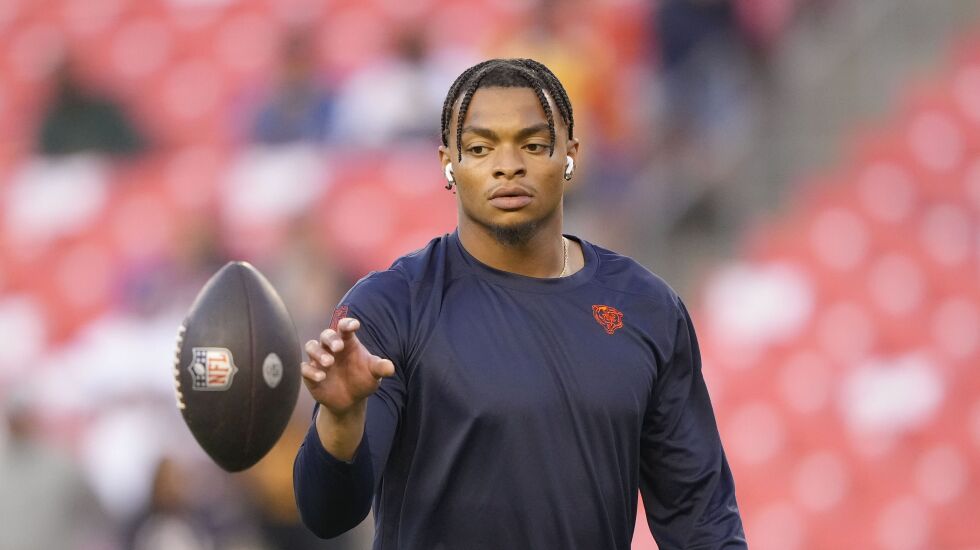
Things are going better for Bears quarterback Justin Fields, and you can see it in his face.
At the start of this week, he sat dejectedly, head down, in full uniform at his locker at Soldier Field after playing a big part in the Bears blowing a big lead against the Broncos.
Four days later, he looked much different after throwing for 282 yards and four touchdowns in a 40-20 win over the Commanders. Between his laughing with the “Thursday Night Football” postgame crew and his buoyant news conference afterward, it was the most the Bears have seen him smile.
“That feeling was a feeling that you never wanted to end,” he said.
In the NFL, it always ends.
A day after Fields gave arguably the best performance of his career, it was already time to ask: What’s next? To become a franchise quarterback, he must make games like Thursday’s more common and less surprising. He must jump from doing it occasionally to doing it consistently.
Over the last two games, he has a 131.3 passer rating, having completed 67.2% of his passes for 617 yards and eight touchdowns. He threw an interception and lost a fumble against the Broncos but was turnover-free for the first time this season against the Commanders.
“You can just see the confidence,” coach Matt Eberflus said Friday at Halas Hall. “When you have growth in your profession, you can just feel it.
“It’s about the execution, and then the consistency of that execution. . . . Just keep stacking them up. That’s what he wants to see, and what we want to see.”
There are measurable signs of improve-ment, too, and signals that Fields is getting closer to the right blend of his instincts from the way he’s being coached. According to NFL Next Gen Stats, he has been taking more shots downfield over the last three games and showing increased trust in his receivers to make contested catches.
Fields threw just 3.3 yards downfield on average against the Packers to start the season and 7.1 against the Buccaneers. The next three weeks, he averaged 14.8, 8.4 and 10.6 yards.
Just 2.7% of his passes in the opener were “aggressive” — defined as throwing to a receiver with one yard or less of separation. That climbed to 6.9% in Week 2. He has been above 17% each of the last three weeks, making several throws into tight coverage to DJ Moore, who had 16 catches for 361 yards the last two games — and that’s exactly what the Bears want. It’s why Moore is here.
“He feels more comfortable making those throws now,” Eberflus said. “And it’s going to continue to grow.”
The Bears have said that before, of course, whether it was about Fields, Mitch Trubisky or various other supposedly promising young quarterbacks.
While Fields bears the weight of that history, he’s also feeling the pressure of an imagined future. As he seeks to prove he’s a franchise QB over the next 12 games, the bar is extremely high because general manager Ryan Poles could have the top pick in the draft again next spring. Fields must offer a definitive case that his upside is higher than, say, USC quarterback Caleb Williams, the 2022 Heisman Trophy winner.
In most seasons, Fields could take that decision off the table by winning enough games to put the Bears out of reach of the elite prospects. But since the Bears have the Panthers’ first-round pick in 2024, it’s likely they’ll be drafting high no matter what Fields does.
They evaluated making a move at quarterback last offseason, too, when they briefly held the No. 1 pick. Because of a coaching transition and roster demolition, Fields got leniency then that he won’t get now. Plus, he’s being measured against Williams, who’s considered a can’t-miss prospect.
Fields will have to be overwhelmingly good. He has only shown he can do that at times. The Bears need it to be most of the time.







